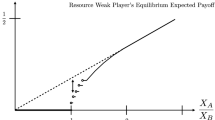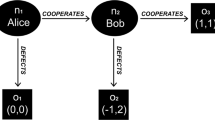Abstract
We consider cooperatives games (TU-games) enriched by a system of a priori unions and a communication forest graph which are independent from each other. These two structures reflect the limitations of cooperation possibilities. In this framework, we introduce four Owen-type allocation rules, which are defined by a two-step application of an allocation rule à la Owen (in: Henn R, Moeschlin O (eds) Essays in mathematical economics and game theory, Springer, Berlin, 1977) to TU-games with a priori unions where the TU-game is replaced by Myerson’s (Math Oper Res 2:225–229, 1977) graph-restricted TU-game. The four possibilities arise by applying, at each step, either the Myerson value (Myerson 1977) or the average tree solution (Herings et al. in Games Econ Behav 62:77–92, 2008). Our main result offers comparable axiomatizations of these four allocation rules.
Similar content being viewed by others
Data availability
(data transparency): not applicable.
References
Alonso-Meijide JM, Fiestras-Janeiro MG (2002) Modification of the Banzhaf value for games with a coalition structure. Ann Oper Res 109:213–227
Alonso-Meijide JM, Álvarez-Mozos M, Fiestras-Janeiro MG (2009) Values of games with graph restricted communication and a priori unions. Math Soc Sci 58:202–213
Amer R, Carreras F, Giménez JM (2002) The modified Banzhaf value for games with coalition structure: an axiomatic characterization. Math Soc Sci 43(1):45–54
Aumann R, Drèze J (1974) Cooperative games with coalition structures. Int J Game Theory 3:217–237
Aumann R, Myerson RB (1988) Endogenous formation of links between players and of coalitions: an application of the Shapley value. In: Roth AE (ed) The Shapley value: essays in honor of Lloyd S. Shapley. Cambridge University Press, Cambridge, pp 175–191
Banzhaf JF (1965) Weighted voting does not work: a mathematical analysis. Rutgers Law Rev 19:317–343
Baron R, Béal S, Rémila E, Solal P (2011) Average tree solutions and the distribution of Harsanyi dividends. Int J Game Theory 40:331–349
Béal S, Rémila E, Solal P (2010) Rooted-tree solutions for tree-games. Eur J Oper Res 203:404–408
Béal S, Rémila E, Solal P (2012) Compensations in the Shapley value and the compensation solutions for graph games. Int J Game Theory 41:157–178
Béal S, Rémila E, Solal P (2015) Characterization of the average tree solution and its kernel. J Math Econ 60:159–165
Béal S, Rémila E, Solal P (2017) Discounted tree solutions. Discrete Appl Math 219:1–17
Béal S, Khmelnitskaya A, Solal P (2018) Two-step values for games with two-level communication structure. J Comb Optim 35:563–587
Casas-Méndez B, García-Jurado I, van den Nouweland A, Vázquez-Brage M (2003) An extension of the \(\tau \)-value to games with coalition structures. Eur J Oper Res 148(3):494–513
Demange G (2004) On group stability in hierarchies and networks. J Polit Econ 112:754–778
Gómez-Rúa M, Vidal-Puga J (2010) The axiomatic approach to three values in games with coalition structure. Eur J Oper Res 207:795–806
Hart S, Kurz M (1983) Endogenous formation of coalitions. Econometrica 51:1047–1064
Herings J-J, van der Laan G, Talman D (2008) The average tree solution for cycle-free graph games. Games Econ Behav 62:77–92
Herings J-J, van der Laan G, Talman D, Yang Z (2010) The average tree solution for cooperative games with communication structure. Games Econ Behav 68:626–633
Kalai E, Samet D (1987) On weighted Shapley values. Int J Game Theory 16:205–222
Khmelnitskaya A (2014) Values for games with two-level communication structures. Discrete Appl Math 166:34–50
Le Breton M, Owen G, Weber S (1992) Strongly balanced cooperative games. Int J Game Theory 20:419–427
Meessen R (1988) Communication games (in Dutch). Master’s thesis, Department of Mathematics, University of Nijmegen, The Netherlands
Mishra D, Talman D (2010) A characterization of the average tree solution for tree games. Int J Game Theory 39:105–111
Myerson R (1977) Graphs and cooperation in games. Math Oper Res 2:225–229
Myerson R (1980) Conferences structures and fair allocation rules. Int J Game Theory 9:169–182
Owen G (1977) Values of games with a priori unions. In: Henn R, Moeschlin O (eds) Essays in mathematical economics and game theory. Springer, Berlin, pp 76–88
Owen G (1978) Characterization of the Banzhaf–Coleman index. J SIAM Appl Math 35:315–327
Owen G (1986) Values of graph-restricted games. SIAM J Algebraic Discrete Methods 7:210–220
Selçuk O, Suzuki T, Talman D (2013) Equivalence and axiomatization of solutions for cooperative games with circular communication structure. Econ Lett 121:428–431
Shapley LS (1953) A value for \(n\)-person games. In: Tucker AW, Kuhn HW (eds) Contributions to the theory of games II. Princeton University Press, Princeton, pp 307–317
Tijs S (1981) Bounds for the core and \(\tau \)-value. In: Moeschlin O, Pallaschke D (eds) Game theory and mathematical economics. North-Holland, Amsterdam
van den Brink R, van der Laan G, Moes N (2012) Fair agreements for sharing international rivers with multiple springs and externalities. J Environ Econ Manag 63:388–403
van den Brink R, Khmelnitskaya A, van der Laan G (2016) An Owen-type value for games with two-level communication structure. Ann Oper Res 243:179–198
Vázquez-Brage M, García-Jurado I, Carreras F (1996) The Owen value applied to games with graph-restricted communication. Games Econ Behav 12:42–53
Zhang G, Shan E, Kang L, Dong Y (2017) Two efficient values of cooperative games with graph structure based on \(\tau \)-values. J Comb Optim 34:462–482
Funding
(Information that explains whether and by whom the research was supported): Financial support from research programs “In-depth UDL 2018”, and “Mathématiques de la décision pour l’ingénierie physique et sociale” (MODMAD) is gratefully acknowledged.
Author information
Authors and Affiliations
Corresponding author
Ethics declarations
Conflict of interest
(include appropriate disclosures): not applicable.
Code availability
(software application or custom code): not applicable.
Additional information
Publisher's Note
Springer Nature remains neutral with regard to jurisdictional claims in published maps and institutional affiliations.
We thank an associate editor and two anonymous reviewers for valuable comments. Financial support from research programs “In-depth UDL 2018”, and “Mathématiques de la décision pour l’ingénierie physique et sociale” (MODMAD) is gratefully acknowledged.
Rights and permissions
About this article
Cite this article
Béal, S., Rémila, E. & Solal, P. Allocation rules for cooperative games with restricted communication and a priori unions based on the Myerson value and the average tree solution. J Comb Optim 43, 818–849 (2022). https://doi.org/10.1007/s10878-021-00811-4
Accepted:
Published:
Issue Date:
DOI: https://doi.org/10.1007/s10878-021-00811-4




